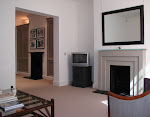 Wooden floors have become extremely popular. The trend moves towards ever wider boards, either engineered or solid. In terms of colour, light oak used to be all the rage until wenge became hugely trendy where furniture is concerned and the general taste in wooden floors followed suite, darkening. Even restricting one’s choices to oak, the old favourite, a number of important decisions remain to be made: namely colour and type of finish. Any type of wood can be tinted, darkening is easiest (through stains) while lightening can only be achieved through liming and similar procedures. My personal preference is to either select a wood I like in its natural state or to opt for a smoked finish. An oak onto which a very dark stain has been applied will reveal its original colour when scratched or dented and this will make the damage considerably harder to repair.
Wooden floors have become extremely popular. The trend moves towards ever wider boards, either engineered or solid. In terms of colour, light oak used to be all the rage until wenge became hugely trendy where furniture is concerned and the general taste in wooden floors followed suite, darkening. Even restricting one’s choices to oak, the old favourite, a number of important decisions remain to be made: namely colour and type of finish. Any type of wood can be tinted, darkening is easiest (through stains) while lightening can only be achieved through liming and similar procedures. My personal preference is to either select a wood I like in its natural state or to opt for a smoked finish. An oak onto which a very dark stain has been applied will reveal its original colour when scratched or dented and this will make the damage considerably harder to repair.Once an exact shade has been agreed upon you will need to select a way of sealing it and protecting the board from traffic. The choice is between polyurethane varnishes and oils (or waxes). The first has to be applied by a specialist who will sand the entire floor and seal it with a number of coats. Ongoing maintenance of this type of finish is easier (just wash with a soft cloth) but damage cannot be rectified without the intervention of a professional who will once again sand the entire floor and re-varnish it. Oils and waxes require more maintenance (oil needs to be re-applied every few months during the first year and twice a year thereafter in my experience). However, oil is a much more forgiving finish. Should the floor become scratched or dented it is possible to lightly stain the scratch (I have successfully used boot polish in some instances) and re-seal it. Oiling a single floorboard is in fact possible and this, in cases of minor damage, is a much more viable solution.
The bottom line is that there is no bottom line with wooden floor finishes. As with most interior design related issues the decision should be made on the basis of how the property will be used. With a rental property for instance I would
- avoid a brushed finish (as the roughness imparted to the board through brushing would be removed by the sanding machine during maintenance work),
- select an oiled finish for short lets (so as to avoid costly maintenance every few months), avoid a limed finish, which shows “traffic tracks” in the most used areas.
As ever, a list of your top priorities needs to be your starting point. Gain some knowledge of products available and find the best compromise between the benefits and drawbacks that come with them. I can’t stop saying it: interior design is as much the art of excellence as it is of compromise!

1 comment:
Thanks for the great information on the floor sanding .
I really enjoy reading your blog, it is very useful for us.
Post a Comment